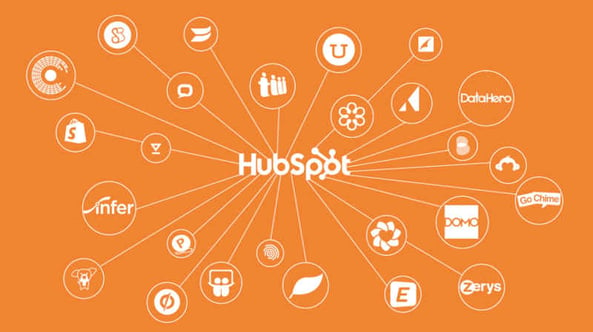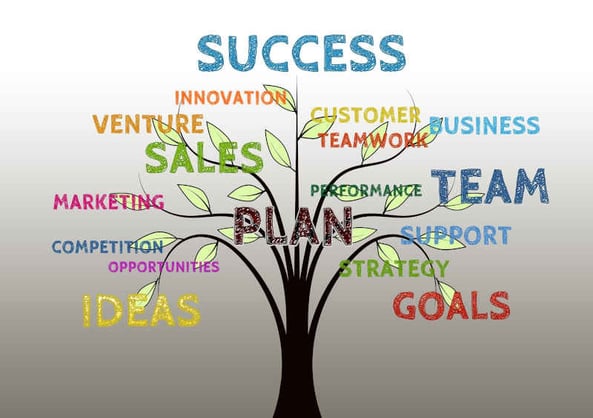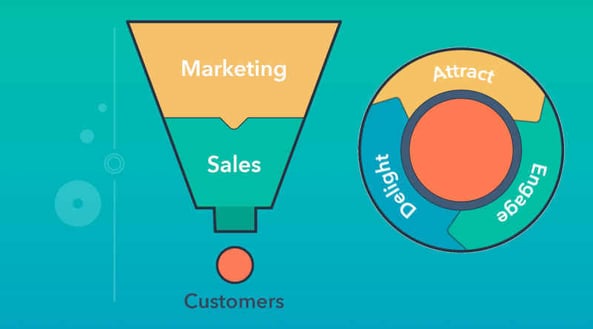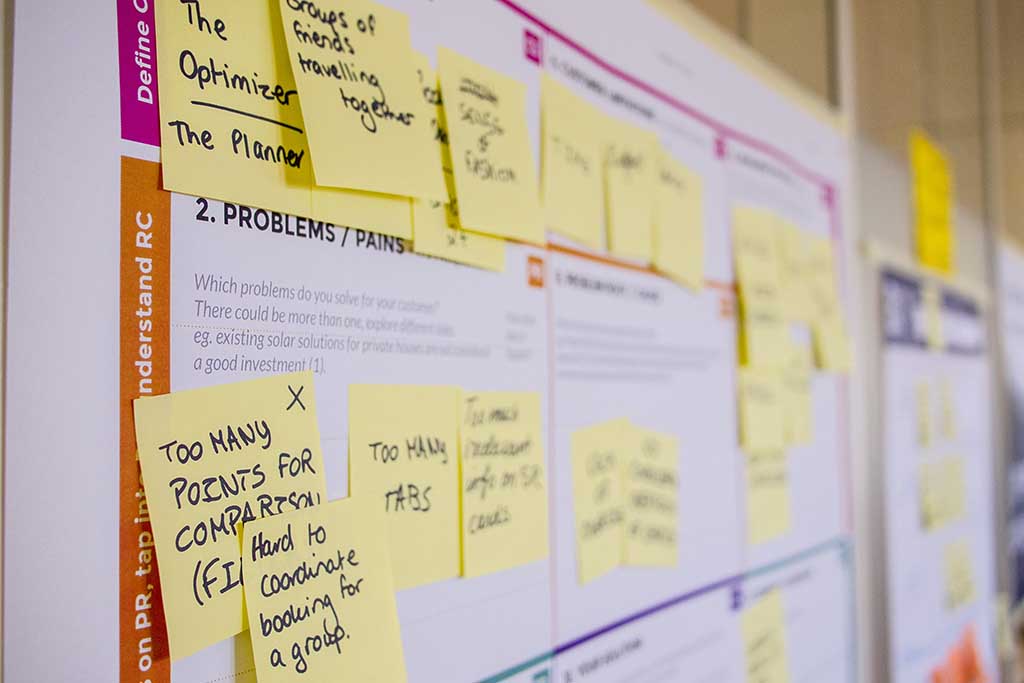How a Sales Flywheel can Grow Your Business Predictably
- Home
- How a Sales Flywheel can Grow Your Business Predictably
This presentation is a transcript of the talk at the HubSpot User Group(HUG) meeting in April 2019 by Andrew McAvinchey founder of Mount Arbor and hosted by Clwyd Probert, CEO of Whitehat an Inbound Marketing Agency in London.
A few of the reflections they had during Dermot and Brian's talks was that this is a revolutionary way to look at sales. But just in terms of what the guys introduced, one of the things that Dermot had mentioned was the fact that inbound was always about the attraction stage in the flywheel. As we know today, we became so good at optimising for that stage that we might have forgotten a little bit about the other two stages: The engage and delight stage. Who in the room can remember a time when you had to fight for a digital marketing budget?
Does anyone go back that far? Good. So that's where I started myself. I remember I got really into digital in the early days and had to fight for that budget. And now that budget has superseded. And I remember hearing from marketing managers in those days: "You can't do what I do digitally." So I'll get into this a bit and we'll talk about that a little bit in terms of how I've worked with clients. Another thing that I kind of wanted to reference was HubSpot. I've worked very hard to generate those inbound leads 50,000 a month. That flywheel is all about continuation through your sales process.
Now, how many of those people convert to a HubSpot customer is the question. So, there are a few things I'd like to cover today. My name is Andrew and I'm the founder of what we call a business growth consultancy that works with businesses to grow based on customer acquisition engagement and competitive advantage. Does anyone know the story of Galileo?
So everyone's familiar with the Galileo story. He caused a lot of trouble with just in how he presented new ideas to the establishment. And it's my view that we're actually moving from the medieval times in terms of sales into a new way of looking at sales through what is the innocuous flywheel and how that looks to us today. My background is that I worked a lot in marketing, sales, storytelling and digital marketing and lots of other areas. But what I'd like to do particularly is to address some of the frustrations that I recognise in sales and marketing as we move into this. Very interesting period for sales and marketing and customer success teams is that all have to work together. And some of you may have beautiful organisations where all that flows perfectly, but a lot of the businesses that I've been working with do have a tendency to silo in those areas. Can anyone relate to that?
"Walk away with a framework that you can use in your own businesses"
So what I'd like to talk about today is how a sales flywheel can help grow your business predictably with inbound sales. My goal is to equip you today to walk away with a framework that you can use in your businesses that I use with my clients. So it's to share that framework with you. And if anyone has any questions about how that works, please just get in touch with me or talk to me afterwards and I'll be happy to go through it, but I'll do my best to go through it today. So down to business. Just give me a sense again, who here is a head of sales or has a responsibility for sales in their business?
So quite a few of you. In terms of a B2B or B2C business selling to other businesses, could you raise your hand if you sell to other businesses? So most of you here sell to other businesses and I believe that's probably predominantly who HubSpot target with their platform as well. So nice synergy there. Organisations of company size say up to 50 people. So this platform is optimised for that size of an organisation. It works well.

Most of you will be familiar with marketing qualified leads or MQL, number of opportunities, opportunities to close rates and the lifetime value of your customer. Does anybody want to tell me the lifetime value of their customer? Did anyone get a sense of it? Who knows the average contract value of their customers?
One, two, three, four, five, six, seven. Okay. So a proportion of you, but I'd love to see that becoming a higher number at the next meeting because I think that with the flywheel you can start to measure and attribute according to revenue and start to see those average contract values. So just some bit of background. I've had a very strange upbringing I've lived all over the world. I've lived in places like Iraq and I had a pretty big family. But through this experience, I've started to see things from different perspectives. I suppose travelling gives you those open perspectives on how to look at things. And that's served me well.
So more about me...
I've got an honour degree in biochemistry from the University College Dublin and I've also got a first in my master's degree in computer science from University College Dublin as well. I'm only mentioning that because I saw the Irish tend to downplay our qualifications. So let's get that off the table. The other thing I wanted to mention is that as well as working with many businesses in terms of their business growth, I've also worked a lot with the arts and with storytelling and that's helped me in digital marketing and sales. I made a lot of films, and short films, and I started a film festival and worked on an interactive feature film with an Oscar-nominated director. So that was an experience that, believe it or not, informs the Flywheel, which I'll go into in a little bit. And I've also lectured a lot.
So that's why I love to teach and I love to see people succeed with their businesses. I think that business can be a creative enterprise. So it's really good fun for me to see those people succeed. And maybe that's why I love teaching. So as I say, I got into sales. Who knows why I got into sales, who chose to get into sales early on in their profession? One person, two. So I ended up in sales much like the rest of you. I started in science or another discipline and ended up in sales. I took a bit of a tangent after science and got into digital marketing. I loved it. I loved the idea of digital marketing. I love the idea of being able to communicate so broadly before Facebook and YouTube. And as they grew, I grew in my knowledge of this stuff and it was so fascinating and that's what gets me into storytelling.

But I suppose the foundation of it all is this scientific view. As I said, I think that the Galileo's view of the universe has challenged the way we see things. The customer journey. We've heard a lot about the customer journey and most of you will have some idea of what your customer journey is. Do you have a customer journey map? Just give me a sense if you've got a customer journey map and your organisation. So very, very few of you have that mapped out for everyone to see. And I think it's an interesting point that as you look at what traditionally is the funnel view. So if you can imagine you first of all, attract that customer to the top of your funnel, like a flower to a bee, and then those bees start to be funnelled through your organisation and they deal with different people along the way.
"It can take 5 to 10 calls to converse someone from an MQL to an SQL and beyond."
So if you can imagine, one of the things Brian mentioned was that it can take 5 to 10 calls to converse with someone from an MQL to an SQL and beyond. But another quite interesting statistic is that it takes 18 touchpoints at the prospecting stage just to engage with that initial prospect. Now someone who's spending that much time prospecting is not someone who's naturally predisposed to close that deal. Brian was talking about where you're qualifying people before your demo, you're getting to know their business, you're asking them questions, you're finding out about their business and their challenges and their goals. So specialisation is a very important part of looking at things from a flywheel perspective
In the future: What I'd like to see happening is that businesses operating a flywheel system are working in this kind of symbiotic way with other agencies, with other partners, with other people. As you see, businesses are starting to distribute the value that they provide to their customers through their organisation, but also they're able to bring people in and out to serve customers in more efficient ways so that the flywheel lends itself to that model. And I'll go into a bit more about that in the rest of the presentation. But the future I think is built on the flywheel. And you know, I'm obsessed with this thing now because when it was first introduced by Brian Halligan last September in Inbound, you could see everybody kind of stroking their chins. We've been working with this funnel for the last 10 years and we've become good at it.

But how is this flywheel going to change things? I think it's a very sneaky way of introducing a new way to organise your business. And as we're seeing it starting to have the effect that it's supposed to have because it's a high-impact change the businesses are seeing. So what I'd like to share with you today are just three secrets that I have observed that I think are very useful in your sales organisation. The first thing is how to establish goals. The team understands, even if they speak different languages. We were having a conversation last night and we were talking about marketing and sales and I asked someone, I asked Edwin actually, what value do your marketing leads have to revenue? Can you trace your marketing needs to revenue? And of course, he was able to say, yeah. I know the value of the MQL that I'm providing to my organisation and my next question is, what about when you hand them to the sales team? Because statistically only 48% of warm leads are followed up by sales teams in most businesses. So if you could imagine the investment people are putting into getting those leads on the marketing side, if salespeople don't follow up, you're losing money.
And that's partly because sales and marketing speak different languages. As I just mentioned, those sales metrics. My question is how many of your marketing people understand those same metrics? Do you use the same terms? Do you speak the same language? The second thing I'd like to talk about is how to build a relationship with your customer without coming off like you've multiple personalities. So if you could imagine a customer moving through your sales process as Brian went through that sales process, what if it's not the same person all the way through?

Once a new person starts to engage with that customer, they might sound like they've never spoken to you before. Bring that back into the marketing department. They're using yet another process to bring someone from the attract stage into the engage stage. They may be using different tones of voice, different language, different approaches, and different content. You're going to look like a different person to the customer. The interesting thing about the customer's point of view is that they don't care if you're in sales or marketing. Their point of view is that just dealing with your business. So the way you deal with them, it needs to be in a unified way. And that's why this, the flywheel is interesting from the point of view of uniting that point of view around the customer. And the third thing I wanted to talk about is just how exactly to use these ideas. Because a lot of the time these concepts get challenged. Okay, but I'm in sales, I've got to make money. So how does this relate to revenue? How does this relate to customers, to profit, to do those things that the people I work with, those sales leaders and the CEOs of companies and possibly the board and the CFO, what do they care about and how do you relate these efforts to those revenue streams? That sounds good.
Establishing goals
So first of all, how to establish goals. The team understands if they speak different languages. The first thing I always ask a new person dealing with this stuff is if I were to throw a thousand leads at your sales organisation tomorrow, but they had to be followed up within five minutes, how would you cope? And then if I threw another 10,000 needs at your organisation, how would you cope with any of those leads? Get jammed up with any of them, and fall through the cracks. Would you lose any? And once you know the value of those leads, would you be concerned?
"A lead that's followed up within five minutes is a hundred times more likely to be warm when you speak to them."
So the first thing to do, I believe, is to solve this problem where leads get jammed up in your sales process. Somewhere along the way, leads are falling by the wayside leads are falling through the cracks or leads aren't being followed up. Brian mentioned earlier that HubSpot followed up within five minutes. The reason for that is that there's research to indicate that a lead that's followed up within five minutes is a hundred times more likely to be warm when you speak to them. This means that every five minutes afterwards they're dropping off an interest and an hour later you might as well have never received the first touch. And research says that a five-minute follow-up is the way to go. So the question is how do you start to move your leads through your sales engine efficiently? So the first thing I would do in a sales system is to say let's get one lead smoothly through your sales organisation so that your sales system can confidently move a lead smoothly through the sales organisation to close. And once you do that, you can turn up the volume and invest in marketing. Because if you think of marketing as investing in fuel for your sales engine, if you throw that fuel, Internet and efficient engine, you're burning fuel and money.
So the first thing to do is to start to optimise that sales engine. Nope. The view of sales on its own is no longer valid. There are lots of different departments in a company that will help you to align your business around the customer. And we're all familiar with that idea. But when I worked with businesses and when we look at any business, they each have a lot of different departments working on a lot of different things with the fundamental things. Who do you sell to? What do you sell? Those are questions that have big assumptions behind them. Oftentimes if you go around the business, not everybody knows. This is one of the reasons those personas that HubSpot focuses on so much are so important. Who do you sell to? The second thing is to figure out exactly what product you sell. Now, in the SAAS world, product morph configurations are different for every customer.

HubSpot is the prime example. It's going to be an entirely different configuration for you. Everyone is going to have a different configuration of HubSpot set up according to their business.
So it's very difficult to say you want to buy your watch as a salesperson. So defining those product types and defining what you sell in defining the value that is provided to the customer is extremely important.
The sales enablement and messaging point of your sales process. Then we look at where you sell and how you access that market. That's your marketing. And then why and when someone would buy from you is the job of the sales team. All of these things need to flow together so that when the customer gets the value from your product, how that happens needs to be clearly defined. So let me ask you a question. Who likes warm word-of-mouth leads? Why do you like warm word-of-mouth leads? Ask yourself why you like warm leads that convert. So what is your strategy for getting more word-of-mouth leads? Do you have one?
What strategy are you using?
Strategic Relationships, incentives, testimonials. All of these strategies have to do with allowing your customers to feed back into your flywheel. So from the point of view of your organisation, if your number one source of warm leads is going to be those customers who are at the top end, the 11 o'clock of your flywheel, you need to be sure that those strategies are in place across the organisation.
Everybody's feeding nuts. So the first thing you'd need to do is build a relationship with your customer so that you don't look like you have multiple personalities. Now, oftentimes in the technology world, salespeople will say to me you kind of automate. What would I do? There's no way you can automate sales. I'm a people person. I want to talk to people. I understand people, I understand how to understand what they need. And I say, I agree with you, but what is it that you're doing as a salesperson? What is it that you do?
Now the technologists in the room would say a lot of it can be automated through AI and big data and personalisation. And there's a huge push for this and HubSpot is an amazing platform for very simple personalisation. For example, if I come to the website from Ireland, I might see an Irish landing page. If I come to the website from Australia, might see an Australian landing page for the smart content that offers.
So it's a brief glimpse of the future of personalisation and the kind of advances that are being made around how to contextualise a customer and serve them the right content according to where they are in their buyer journey. So again, how do we get back to what salespeople do today how do we optimise for that and how do we give more value to the customer today?

Well, the first thing we need to do is address this thing, the big elephants in the room, because who's in marketing again? Okay, so most of you are in marketing. So there is this kind of chasm that opens up between marketing and sales.
If you're a smaller company with three, or four founders doing most of the sales, it's kind of intuitive. You know how to transfer your marketing to your sales because you're the same guy. But in an organisation that has marketing over here and sales over here, they're using their SAAS tools and there's probably about 50 of them stacked upon each other. If they're sophisticated, they're doing well. And then out-pops an MQL or an SQL and then they get transferred into your sales CRM, whether it's Salesforce or Zoho or whatever you're using.
A customer is 57% of the way through the buyer journey when they come to you to buy something.
And then the sales team has to bring those leads through their sales process, which marketing may not be aware of. And I saw a few of you do have your sales process documented, but I think it's essential that everyone understands the sales process. But this chasm is where I think the most value is because this is where an organisation can capitalise on what a customer expects.
A customer is 57% of the way through the buyer journey when they come to you to buy something. They're more informed than they've ever been. We used to sell based on having more information. Now we don't have that anymore. So what can we do?
This chasm is where we can transfer the knowledge that we understand about the customer, to the salespeople so they can start to tailor solutions to the customer. Next, how to optimise your sales without breaking anything, slowing down or hiring a used car salesman to run your sales team. So this guy, you know, when I think of a salesperson, I have the same prejudice. But Daniel Pink wrote a great book called "To Sell Is Human".

What he was saying was that everybody's selling all the time. You may not think it, but you're selling. Everyone's a storyteller. You may not think it, but you're telling stories all the time. I was walking through a doorway yesterday and as the door opened, the lady said "Right through this way." and the other lady said, I don't know if I told you, but my husband died in March. What a story.
I walked into the bathroom and I just went, wow. Stories are everywhere. These storytelling ideas and these ideas of how we relate to people are not the same as you used car salesmen trying to sell you a car. And so the idea of being a salesperson is changing. Our view of salespeople as we think of sales has to change because it's no longer valid. Daniel Pink did a survey and he asked people, what do you think of when you think of sales? And people said, pushy, tough, sleazy, Ugh, yuck. These terms just describe the most disgusting profession.
So why would anyone want to get into sales? The most trustworthy of professions are: Can anyone guess what's the most trusted profession? It's a firefighter or a doctor. The least trusted. And, ironically, my father's a doctor, the least trusted is down here. 3% salesperson. So you can imagine what my father said when I said I was getting into sales.
So the trustworthiness of salespeople in general tends to be very low in people's perception. So we've got to start to approach customers and prospects in more advanced ways and use the technology and use the advantage we have to provide value through the sales process.
Now this is a very scientific one and I actually thought, while I wondered the hall here, we're in a very appropriate place for all of this because I noticed there's the school of crystallography, which was the origin of the DNA view that we have today of how our bodies are composed and how genetics are composed. I also noticed that the school of Psychological Sciences is just around the corner.
So our whole mindset is shifting here based on the new psychology of how sales work. This is a graph to illustrate that it's very, very scientific. And basically what it relates to is just over time, what kind of salespeople are going to do the best for your business?
This varies up and down, up and down. People will say, I need lots and lots of novice salespeople. I bring them in millennials who know how to use the phone and they're on the phone all day long and we just need a lot of those guys and other guys. Other people would say, no, no, no. What we need is the Alec Baldwin Guy.
"They're empathetic, they understand value, they see the whole organisation and they can get right inside the business of the customer. "
Always be closing the guy who comes in with a pile of leads and says, you get these piles of leads if you do a good job, but otherwise, you're fired. So this variation in how we see what salespeople need to be and at the moment, this inbound seller is the one that's making the most deals.
They're empathetic, they understand value, they see the whole organisation and they can get right inside the business of the customer. These people are people who can look at both marketing and customer success as part of their journey and as part of their career path. So they're not entirely focused on sales. What they're most interested in is not the lead list from the always-be-closing guy, what they're interested in are warm leads and the information about them.

So marketing's job is to provide that information to those salespeople so those salespeople can provide the most value to the customer.
39% of salespeople didn't intend to go into the sales profession and I think it was about 90% of the people here didn't intend to go into the sales profession. Another preconception is men and women in sales.
Do you agree with the following statements? I intend to go into sales as a career choice. Most women in sales disagreed. So they did not intend to go into sales. But actually, women in sales tend to fare better than men in the modern sales systems that we see today.

So Dan Tyre is famous for his fist bump and his enthusiasm. I was recently in with Dan Tyre in one of his training sessions a couple of weeks ago and the guy is just infectious in terms of how he sees sales.
He's 30 years in sales. It was one of the first people in HubSpot who be in this. He was the first person in HubSpot selling. He developed their entire sales team and over the 30 years of his experience, he's saying that even in the last two years sales have changed fundamentally.
So the things that worked two years ago, no longer work today. Things is happening in sales because of the Internet, because of the available information and because of the expectations of your customers that are fundamentally changing what customers expect from you in sales.
This is a great blog article that you want to read about some of the things that I would encounter quite a bit with new clients where I would say, guys, you need to maybe think about stopping selling by field sales. Stop sending people on planes.
Every time you get a prospect, it's costing you a lot of money and the conversions aren't great. You need to stop cold calling. The conversions and cold calling are minuscule. The effort is not worth it. Now, that's not to say Brian was calling people how many times a day, two hours every day; 40 or 50 calls a day.
So who is he calling if he's not cold calling? Who is calling our warm prospects? He's researching, he's understanding and not LinkedIn hack where you look at the person and say, you know, I know something about this person.
It's going to open the door, I'm going to understand a little bit more about them because I'm there to help. I'm no longer there to close on the call.
Where do I start?
The performance factors that you need to implement to get all this going. Because I know some of you might be thinking, okay, this all sounds great, but how do I do it? The answer is to start to look at different areas of your business and build a foundation for a sales system that works in the modern flywheel.
So the first thing you need to look at is your structure. And I turned to HubSpot for structure. Most of the clients I worked with as a consultant over the last 20 years and I worked with big companies and small companies. So I was a consultant for Google on their AdWords product. I was a consultant for IBM and Vodafone.
I was also working with a sales methodology company. One called Taz or Altify focused entirely on salesforce and sales methodology on that side and start-ups. So analytics companies, a company called Zoo Tech, who I want to show you a case study about and all of these companies use HubSpot.
it was a HubSpot partner, they used HubSpot on the marketing side. What I want to show you later with a case study is that the sales platform is enormously powerful and can be applied to an enterprise situation.
"How are you going to make sure a customer moves all the way through your sales process"
HubSpot can meet it but whatever you choose, get a structure, get a CRM. The second thing is you need a process and everyone needs to understand that process. Next is strategy, so a word-of-mouth strategy is a good place to start. How are you going to make sure a customer moves through your sales process so they come back wanting more also they're going to tell your friends. Tell their friends and your friends how great you are.
Finally your sales team. Hiring the right people, and understanding who to hire. What questions do you ask in an interview? All of this relates to your flywheel and the new modern sales organization.
Same concept here. Provide a sales framework using inbound sales methodology where you target prospects to warm prospects, people who put up their hands and say, I'm an active lead.
Yes, I would like to talk to you because I understand what you provide and marketing has done a very good job at that point of explaining clearly what it is that you provide. If they move through your sales funnel, they're less likely to walk away at the last minute because they know what you provide and they know they want it. The next thing is your team's effectiveness.
Getting those metrics in place, understanding what metrics to follow through a flywheel. And finally, the five levers, which I'll get into in a second, which is just a handy model for new businesses that you can use to track and measure as people move through your flywheel. So this is the mind-blower. Okay, so modern business is about circles and not triangles.

This is the funnel. This is the flywheel. You could imagine modern businesses are about collaboration, about movement, about applying the right force to your flywheel so it continues to move reducing friction.
What about closing the walls, keeping everything inside, not telling anybody what you're doing popping out, promoting, and attracting customers? I don't want to name names, but I could probably come up with a couple of companies that operate this way.
I will after if you ask me. So the circles and not triangles thing is a really good way to think about things when you're in a workshop.
For example, so last week I ran a workshop with the executive team of one of my clients and there were multiple arguments about where to focus the efforts around enablement content the question is, well where are you in the circle? What time is it?
Our marketing people were saying, we need more marketing content, we need more ebooks, we need more videos. We need to explain what the products do. What the sales guys were saying was, no, no, no, no, no. I need pricing sheets. I need data sheets.
I need something to give the customer when they're just about to buy. Both are valid, but in a circular model, you just have to say, well, what time is it? Where are they on the journey? What's the priority? Where do we focus our efforts?
So just to break it down even further, the idea of being able to buy something is as old as the hills trading. So given that it's HubSpot, sell me an orange.
Traditionally what I would do is in my sales organization, which is on the left, so that kind of triangular hierarchical structure where the head of sales puts in place a few account executives and then there's a few prospectors and they're reaching out to these customers saying, come, we have oranges, they're very nice oranges. Please come to our shop and buy the oranges.
The owners are inside the shop, and I'm walking by Tobias. And then the amazing graphical slide shows that the orange is then sold to the customer. We're all familiar with this. Now, what the flywheel does is it starts to change things. It starts to unify the customer journey. So there's value at every step.
So that scenario where it was like: Come into my shop. There's value there. When they're outside the shop, there's value there. So again, a little bit of the orange the whole way through.
So when did they get the orange? Well, they don't get the orange because first of all, you have to squeeze the orange, squeeze all the value out of that orange into juice and then add the juice to the flywheel. And remember the flywheel is in motion spinning. This is the science. So it's spinning. What happens if you're in the middle of a spinning wheel? You get dizzy.
Has anyone been at the playground? Centrifugal Force? Exactly. You get that pushed out to the edges. The more it spins, the more distributors the value gets. All the value is distributed through the organisation. All the value is distributed to the flywheel, which means fundamentally your salespeople who are closing the sale are no longer the ones handing over the orange.
How do I add value?
Value is mutual. So the sales guys are used to getting the huge commissions because they were getting all the revenue. After all, they're handing over the orange.
Now as HubSpot has done, these guys might be handing over more value in customer success or these guys might be handing over an equal amount of value in marketing. So now you've got to think about how to organise your company around the value delivered to the customer.
The second thing you've got to do is to figure out how to compensate, incentivise, and reward your people and organise them around this model. And this is why I think it's changing the view of business as it is today. The same way Galileo did when he started to look at how the Earth revolves around the sun. So this is where I'm going to differ slightly with how HubSpot views the world because HubSpot's still in medieval times as well.
What's happening is HubSpot is calling that orange thing in the middle of the customer. That's not the customer. That's the data that you're gathering about the customer. The customer is up here. You can imagine a little circle here. So imagine there's this circle here.
That circle is moving around your organisation to close and come back for more. In the olden times that would have been the sun rotating around the earth. But now we're changing our mindset. So now what we're going to do is we're going to say that the company orbits around your customer to change your perspective. The little planets that we were seeing before revolving around your organization are the centre of gravity for your company. Your flywheel is rotating around the customer.
Leave that one with you. Let's get back to the really specific areas of what we can do to capitalize on this point of view. So the first thing we want to do is map the flywheel to your sales organisation. And again, this is a really interesting way to look at things because when you start to specialise your sales teams in terms of prospecting and closing; it's like people at dual purposes, if they're trying to close and qualify at the same time as connecting and helping you've got someone who just jams up in the middle of the call.
We've all been there. You're having a nice chat with someone there, helping you out, and then you're like: "You want to buy something?" And it just doesn't feel right. There's a jam. But what you can do is you can start to just equip your prospectors to prospect and your closers to close. Different disciplines for different activities.

As long as everyone's aligned, you can start to do it. And the way that HubSpot has, we are starting to qualify people so that you're not spending all day doing demos.
You understand the business and specialise according to active generation, qualification, conversion, opportunity management and customer success. So this is where your active leads come from the top layer. So this is where marketing did their inbound marketing and bringing leads in and your sales prospectors are doing outbound marketing and bringing leads in. They work with the same KPIs and there's a lot of leads coming in.
The next part: Qualification, identify, explore qualify and identify, connect, explore and advice. Whatever methodology you're using, this is where we start to look at the band and all that kind of stuff to see what kind of timelines they have, what kind of budget they have.
Are they ready to commit or should you just kick them down the road and say, come back to me in three to six months. When we move down into conversion, this is when I was saying to Brian that the idea that you just don't spend time demoing to everybody is really important if you're growing and scaling your business.
This is where online presentations and in-person presentations will increase your capacity to grow your business because qualification out is almost as important as qualification in as the guys mentioned. Following up, where do you focus your efforts?

These are the five levers I wanted to get into. This is just a model but it works. A new person wants to grow their business and the first thing they're going to say is, what do you want out of this engagement? And the first thing they'll say is, I want more customers. And then they'll say, I want more revenue. And then they'll say, I want more profit.
The thing that I kind of find hard to admit sometimes is I don't have any direct influence in those fights on those three things. I can't hold a gun to someone's head and say, you have to be a customer of this business.
So what do I have a direct influence over? Break it down into five. The first thing, I have direct influence over our active leads. So these are the people who put up their hand and go, yes I'm interested and I can invest in marketing to get more active leads.
There are a bunch of other strategies that can use all of you and probably know more than I do about this. How to get more leads through inbound marketing.
The proportion of people who convert to customers is going to be a win rate. So who knows their win rate? Just someone. Does anyone know their win rate?
What's your win rate? 28% brilliant. Very accurate actually because the industry standard would be about 35%. Well, if you're lucky. So the win rates going to be quite important because you can increase your win rate with strategies like better messaging, and better sales enablement because these are the people who get all the way down to the pricing stage where they're starting to price and starting to commit and they're not sure what they might commit to working with you.
The only two reasons they might walk out the door are a competitor got them or else they were under the wrong impression. They thought you were selling them something that you don't have.
So the win rate's important and their strategies around that. Once you have the number of customers, the way you get revenues, is you charge them the right price. So if I want 10 euros from one customer, I'm going to charge them 10 euros.
"How much efficiency can you introduce to increase your profitability."
If I want a hundred euros and I've got 10 customers, I need to charge them each 10 euros. Price variations are things you can experiment with and in a scientific way, change will variable any of these levers at one time and you'll see the effect it has on customers, revenue and profit.
Finally, once you have your revenue, you can multiply your revenue by percentage profitability. So this relates to how much it's costing you to deliver the product. How much efficiency can you introduce to increase your profitability? That percentage can be increased or decreased and give you a different profit.
Finally, this is a new business, but if you introduce repeat business as a coefficient into that second line, you'll start to see that repeat business gives you a bit more revenue. So for every customer you have maybe two out of 10 add more revenue to your business model.

So that's very mathematically. Some people are analysts, some more abstract people. Who likes math? Okay. So a few of you like that one. I'll move on.
This is good, but if you'd like maths. So this is just about the disproportionate effect it has. If you start to just focus on one lever at a time. So any one of these levers; if you increase by 20% it has a disproportionate effect on things like customers, revenue and profit.
So in this case, I've increased active leads, win rate, sales, price, repeat business and profit margin by 20% each. But my customers have increased by 44%. My revenue increased by 207% and my net profit increased by 248%. This is how I blow people's minds because you kind of think, a 20% increase in active leads might not be unattainable.
Just doing that alone, because a lot of this can be overwhelming, just focus and prioritise active leads. If everything else is bench-marked and moving smoothly in that sales engine, you will see an increase that's disproportionate in the other areas.
So what is a sales flywheel for predictable sales? Apply these same metrics, these five levers to your flywheel and measure them through the organisation in a way that everybody's clued in on what you're achieving.
In that way people can all input into those levers and in terms of initiatives, we're all realists, we all work in quarters or every year to establish and maintain our goals. I found this to be a great model for just aligning people in your sales organisation. And when I say as an organisation, I'm talking about the distributed sales organisation throughout the entire business.
If everyone's on the same page with what levers you're going to focus on, there are unified efforts to increase those metrics.
So the flywheel is about reducing friction and applying force. So again, it's just give it a spin and see what kind of forces you can apply to get things moving. And you know, with an engine, with the flywheel, you've got to make sure that it spins before you get going.
One of the things I noticed for example, working with a starter company rather than a grower company is that you first of all have to establish that if those leads do come through, your customer success team can deliver quickly enough. So if everything gets jammed up, you've got friction.
So you've just got to make sure everything spins first. The next thing you do is apply those forces and that's where investment comes in. That's where you can start to apply that force through an agency or your team on the marketing side the sales side or the customer success side.
I was speaking with Pete earlier, he was talking about PandaDoc and PandaDoc is a great proposal system that allows you to work in an integrated way with creating proposals, creating sign documents through the HubSpot platform.
This is a perfect example of how Pete's smaller flywheel compliments the spin of the bigger flywheel that he works with. He comes in, he can work with PandaDoc that spins his business, his business spins another business and it's all spinning and adding force to that flywheel.
I love it. So applying force: the guys went through some of the ways that HubSpot are doing this. They're not the only ones doing this. Amazon has a flywheel. LinkedIn have a flywheel, Google have a flywheel. I won't go into the Google one. It looks like the London Tube Map. Every one of the bigger technology companies has a flywheel internally to motivate and distribute the organisation.

There's some Brian Halligan article on the HubSpot blog around this. Just exactly how to break this down and Dermot has a lot of this in his slides where you can break down exactly what you can do in marketing to apply force, sales and success. And the key here is that if I make a sale and it's caught back on my commission; if that sale doesn't stay, I'm going to make sure that I follow up on that customer after they've closed. I'm not just going to wash my hands and walk off and prospect more close more deals and be completely isolated.
Frictionless strategies
Reducing friction, finding sources of friction. So for example one of the things HubSpot identified was that people wanted to try before they bought without talking to a salesperson.
One of the great things about HubSpot, particularly the sales platform, is that you can use it for free today without paying any money and it's really good.
So you can have the messaging, you can have your calendar app, the Chat Bot, you can get the email integration. I think through the CRM there's a bunch of tools there that you can just get for nothing and that you can see value from straight away. One of the hardest things about getting salespeople to use a CRM is they can't be bothered.
They don't like CRMs, they don't want to sit in the café for like three hours and enter data. What HubSpot does very cleverly is it just pulls it from the email that they're sending to the prospect. So another thing about HubSpot is that it's not the perfect engine.
It's nowhere near perfect, but it's going to give that unified middle ground for an entire organisation to do things like having a calendar app that allows you to book a meeting by just clicking a button, having that kind of Chat Bot on your website, having those things that people expect.
Finally, just to talk about the flywheel we have in terms of the customer. So again, we're reversing our point of view. The big source of gravity here is the customer. What motivates them, what are you doing for them in their journey and flywheel? They're moving through their journey. And what I realised was having worked in storytelling and having worked in film; filmmakers deal with this all the time.

So Captain Marvel, who's seen Captain Marvel? Okay. So just take any of the Marvel movies, they're mythology movies. They're about a hero. Joseph Campbell, many years ago, read all the books that have ever been written. He was a guy in the 60s. Who's heard of Joseph Combo?
The hero's journey. What he described was all of the historical mythologies. All had the same journey when it came to the hero. The reason those stories are compelling, the reason Captain Marvel is what is the highest-grossing film ever made is that it follows this formula to that every person can relate to it because every person, when they have a challenge, when they want something to change, they exit the ordinary world and they go to a call to adventure.
Call to adventure is when you're talking to the prospect for the first time. Do you want to change?
"My business is going to be a success."
Is there something you'd like to do? This journey's going to be painful. This journey is not going to be easy, but I'm going to be there for you the whole way through.
The second thing that happens is you meet with your mentor. You meet with Yoda in the jungle and you start to learn the forces of the Jedi. This is your account executives and your sales engineers helping that customer through the journey. You're going to be tested, especially when they bring out the price, especially if you're buying HubSpot platform, especially if you're thinking about price, but what they have to do is to tell you, look, it's going to be worth it.
If you're measuring metrics like these, you're going to see the value, the ordeal, the reward, seizing the sword. Okay, I'm going to go for it. And then coming back to the village, coming back to your friends and your family and saying, I just figured this out.
My business is going to be a success. So generally speaking, Joseph Campbell was just saying: "Look, these things are universal. Trust me, I read all the books. You don't have to. These things are universal." If your organisation is organised around a flywheel, the compliments, customer's journey, they're going to feel better. Just like if the hero was sad, it would rain. Just like if the princess was happy, the sun was shining. These things internally, your culture, your vision, all of these things are very important to customers on their journeys.
What solutions do you use to achieve these things? HubSpot has broken it down into four areas and I think these are all very relevant. The first thing is to look at CRM implementation, then sales enablement, sales and marketing alignment and sales coaching.
Generally, I wouldn't advise anyone to do two at once. It's very difficult to do two things at once, particularly in one business. There's no harm in optimising your sales and marketing alignment first or getting your CRM set up first and then moving into the other areas.
I would advise a very phased approach to these four areas. If you've got investment, if you're working with a company that wants all of these things, definitely go ahead. But there's so much involved and going through these, which I want to kind of show you in a second, but there's so many things that you have to think about when you're trying to do sales and marketing enablement or alignment.
You need to focus on those things, the real problems. Particularly on that chasm. Mount Arbor.
So just before I get into the case studies, I just wanted to kind of address one thing. First of all, we have changed our name from Sales Hub Pro to Mount Arbor only because when I was doing my own sales prospecting,
I was saying, hello, this is Andrew from ... I couldn't say it. So I've changed to Mount Arbor Partner because it's easier to say, but also because what I noticed was that a lot of my clients are companies selling technology to less digitised industries.
So McKinsey had a study where they looked at how digitised our industries like construction, healthcare, and education, those types of industries are. And what they noticed was these red gaps down here; these are industries that just have no digitisation whatsoever.
They're just terrible. Construction, for example. No digitalisation, they're still using paper and pens. So selling to those customers is very difficult because you're fancy sales process. You're fancy sales organisation internally means nothing to that construction worker and going: " Nope, don't want to talk to you.
Too busy. I don't use mobile phones, so I didn't want to know."So how do you tailor your sales process to that very unusual customer? And I think the right way to do it is to look at that flywheel approach by understanding your customer's journey and then matching your flywheel.
Resources
Ebook – How to align Sales and Marketing teams
Ebook – Tips for a Successful Inbound Strategy
The Interactive Guide to Inbound Marketing




